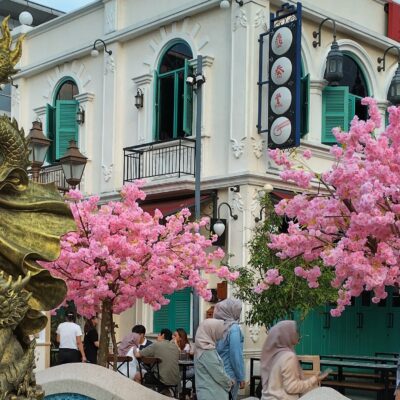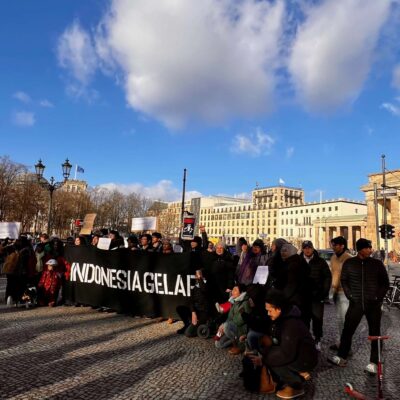On 14 February, Indonesians will head to the ballot box to choose between three men vying to succeed President Joko Widodo (popularly known as ‘Jokowi’). All three presidential candidates – former governors Ganjar Pranowo and Anies Baswedan, and current Defence Minister Prabowo Subianto – have paired with male running mates: respectively Mahfud MD, the Coordinating Minister for Politics, Law and Security; Muhaimin Iskandar, Deputy Speaker of the People’s Representative Council (DPR); and Gibran Rakabuming Raka, the Mayor of Solo and also Jokowi’s eldest son.
The absence of women in the line-up of candidates contrasts with Indonesia’s noteworthy progress in women’s political participation and representation over the past ten years. This development is largely because of the introduction in 2004 of a regulation setting gender quotas for party lists, which requires women to make up at least 30 percent of candidates for all national, provincial and local parliaments and 30 percent of positions on party committees. Although there are problems with implementing this regulation, over time the percentage of parliamentary seats won by female candidates has risen from a meagre seven percent in 1999 to just over 20 percent in the 2019 elections.
In addition, women hold important political positions, including in the cabinet, where three prestigious posts are currently held by women: Sri Mulyani Indrawati (finance), Retno Marsudi (foreign affairs) and Siti Nurbaya Bakar (environment). At the regional level, too, women have made their mark: the Governor of East Java Khofifah Indar Parawansa, who was widely rumoured to have been considered as a vice presidential candidate, enjoys significant support from Indonesia’s largest Muslim mass organisation Nahdlatul Ulama. Another example is Tjai Chui Mie, a Chinese-Indonesian local politician and former mayor of Singkawang in West Kalimantan. Perhaps the most prominent example of women’s political influence is former president Megawati Sukarnoputri, chair of the PDI-P, who has been described as “Indonesia’s most powerful woman”. Yet she is the daughter of Indonesia’s first president Sukarno. Her own daughter, Puan Maharani, is the Speaker of the DPR and is heir apparent for the leadership of PDI-P, perpetuating the dynasty.
The prominence of these women, however, remains the exception rather than the norm for female politicians in Indonesia. Similarly, in legislative elections, the effectiveness of gender quotas is undermined by the ranking practices of male-dominated political parties, which continue to place women lower on party lists, reducing the chances for women to be elected. One study found that voters favoured the first three candidates on party lists, who are mostly men. Moreover, when women are elected, they are often part of an elite family: in the last two elections, almost half of all women elected were related to political families and these candidates relied on the financial resources of male relatives to support their campaigns. This highlights how class dynamics influence women’s political representation in Indonesia.
The absence of women on the presidential tickets illustrates the barriers to women’s political representation. This was further underlined in the first of five presidential debates, in which out of the 11 panellists posing questions only two were women and most of the audience was male. It is then perhaps not surprising that issues of women’s rights and gender equality do not appear to be high on the political agenda. Indeed, in the debate, key discussion points were corruption, Prabowo’s human rights record, and security in Papua. Women’s issues were minimally discussed, and jarringly placed in the broad context of minority or vulnerable groups: Ganjar Pranowo, for instance, stated that “especially pregnant women” need protection. There was no discussion of specific plans to enhance women’s participation and leadership, including in politics and business. Thus, a gender perspective is lacking at the centre of all policies.
The candidates also position women in the context of socio-economic development. For example, for some time now Prabowo has advocated the revolusi putih (white revolution) program, which aims to improve population health through the provision of free food, including the free consumption of milk. This program seeks to address one of Indonesia’s key health challenges, stunting, which has been estimated to affect over 20 percent of the population. However, by emphasising the role of women in this program, it overlooks the fact that reducing stunting is not only a matter for women: it equally needs the active participation of men.
The candidates’ vision-mission documents largely portray women as a minority in need of protection. For instance, Anies Baswedan and Muhaimin Iskandar’s program mentions women the most of all candidates: our search for the keyword perempuan (woman) resulted in 19 hits as opposed to 5 for Ganjar Pranowo and Mahfud MD, and 11 for Prabowo Subianto and Gibran Rakabuming Raka. This may be related to the different lengths of the vision-mission documents: Anies and Muhaimin’s program is far more detailed than that of the other candidates. Nonetheless, women are discussed as part of the candidates’ plans for kelompok rentan (vulnerable groups), including children and people with disabilities. By framing women as a vulnerable minority, the candidates correctly imply women in general do not share the same power, privileges, rights and opportunities as men, yet they fail to address the systemic nature of inequality. The result is to potentially normalise this marginal status for half the population.
Where the candidates do provide a rationale for women’s empowerment, they make a link to national and economic development. Prabowo and Gibran’s program states that by providing women with “education, work and political participation”, gender-based discrimination will be eliminated. Elsewhere, they state that gender discrimination must be eliminated so that women can “fully contribute to development”. Similarly, Ganjar and Mahfud focus on strengthening women’s position in the workforce, and in this context propose increased parental leave at full pay, for both women and men. While this is important and gender equality indeed supports economic productivity, it is about more than that: the advancement of gender equality is linked to poverty reduction, supports health and education and the well-being of all in society. Its importance thus reaches far beyond the economic realm.
Furthermore, the candidates’ discourses on women are strongly focused on their reproductive roles. This was evident in Ganjar’s comments during the presidential debate on pregnant women, but Anies and Muhaimin’s program particularly stands out in this regard. While this program is the only one that directly addresses women’s political participation (including a stronger presence of women in foreign policy and diplomacy), it also includes a section on memuliakan Ibu, which can be translated as ‘honouring mothers’. Although the word ibu can be used as an honorific to address adult women, it is strongly associated with married women, especially those who are mothers. This could be interpreted that women are honoured only for their role as a wife and/or a mother. Moreover, in this section, and indeed elsewhere in the program, attention is given to pregnant women and better facilities for families, including health care and recreation, as well as more support for female-headed households and families with special needs. This approach emphasises and reproduces traditional gender norms that are strongly rooted in Indonesian politics and society, and which historically have significantly constrained women’s political participation.
Women are not only absent from the line-up of presidential candidates, the respective presidential programs lack a comprehensive gender perspective. The way in which women are characterised by the candidates – as minorities in need of protection and assistance, as targets of development programs, and predominantly mothers and wives – illustrates that Indonesia’s political system is not yet inclusive of women and gender issues. Instead, it is a reminder that, despite progress in women’s political participation, entrenched gender norms that emphasise traditional roles for women continue to challenge gender equality – both at the grassroots and the top.
Prasakti Ramadhana (Dana) Fahadi is PhD candidate in Gender Studies, the School of Historical and Philosophical Studies (SHAPS), Faculty of Arts, The University of Melbourne.
Amalinda Savirani is Associate Professor in the Department of Politics and Government, Faculty of Social and Political Sciences, Universitas Gadjah Mada.
Ken Setiawan is Senior Lecturer in Indonesian Studies, Asia Institute, Faculty of Arts, The University of Melbourne.
This article is part of a special co-published series on the Indonesian election led by Asialink’s Insights.
Image: Women’s march in Jakarta, April 27, 2019. Credit: Eunike Melvi/Shutterstock.




